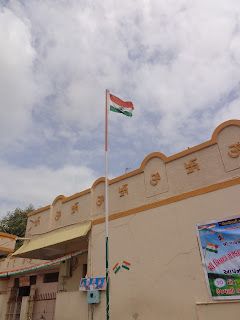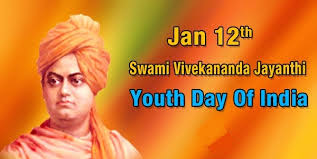Rules for Flag Hoisting in India on Republic Day
"A
flag is a necessity for all nations. Millions have died for it. It is
no doubt a kind of idolatry which would be a sin to destroy. For, a flag
represents an Ideal The unfurling of the Union Jack evokes in the
English breast sentiments whose strength it is difficult to measure. The
Stars and Stripes mean a world to the Americans. The Star and the
Crescent will call forth the best bravery in Islam."
"It
will be necessary for us Indians Muslims, Christians Jews, Parsis, and
all others to whom India is their home-to recognize a common flag to
live and to die for." - Mahatma Gandhi
The Indian Flag is a national symbol and it is respected by every citizen of India.
There are certain points to remember while hoisting the Indian Flag.
The Indian Flag should be hoisted with the saffron color on the top.
There should be no flag or emblem either above the National Flag or on its right.
If there are multiple flags to be hoisted, they must be placed to the left of the Indian Flag.
During the hoisting of the National Flag, all present must stand to give respect and honour its glory.
The
flag cannot be intentionally allowed to touch the ground or the floor
or trail in water. It cannot be draped over the hood, top, and sides or
back of vehicles, trains, boats or aircraft.
The flag cannot be used for communal gains, drapery, or clothes.
The National Flag should be flown from sunrise to sunset, irrespective of the weather. It must be taken out before sunset.
Republic Day Parade
The main celebrations of Republic Day are held in the form of a colorful parade near India Gate in Delhi. The parade showcasing India's
military might and cultural diversity covers a 8 km route, starting
from the Rashtrapati Bhavan through the picturesque Rajpath down to
India Gate before winding up at the historic Red Fort in Old Delhi.
The
events of the day begin with the Prime Minister laying a wreath at the
Amar Jawan Jyoti - India Gate. He then drives up to the central
enclosure and awaits the arrival of the President and a Chief Guest of
the occasion who is normally a Head of other Country.
On
his arrival the Hon’ble President meets the dignitaries present and
unfurls the National Flag. Following this the National Anthem is played
with a 21-gun salute to the National Flag. After this a brief
investiture ceremony takes place during which the President presents
India's top gallantry awards, the Param Veer Chakra, the Veer Chakra and
the Maha Veer Chakra to the outstanding soldiers from the defense
services.
After this, four helicopters from the armed
forces fly past the parade area showering rose petals on the audience.
Each chopper carries a flag - the first being the Indian flag and the
other three the flags of the Army, the Navy, and the Indian Air Force.
The
march past begins immediately after the fly past. The President, as
Commander-in-Chief of the Armed Forces, takes the salute of the mechanized, mounted and marching contingents of the Army, Air Force,
Navy, Paramilitary forces, Police and the National Cadet Corps.
After
the march past comes the cultural extravaganza consisting of floats
presented by the various states and performances by school children.
After the floats, the bravery awards winning children from all over the
country enter on elephants.
A spectacular fly-past by
Air Force and Naval aircraft rounds off this not-to-be missed
experience. The parade is followed by a pageant of spectacular displays
from the different states of the country. These moving exhibits depict
scenes of activities of people in those states and the music and songs
of that particular state accompany each display. Each display brings out
the diversity and richness of the culture of India and the whole show
lends a festive air to the occasion.
No other country
in the world can parade so many ethnically different people in splendid
uniforms as India's Armed Forces. But they are all united in their
proven loyalty to the Government elected by the people and in their
proud traditions and legendary gallantry.
Live Streaming of Republic Day Parade in Delhi
The Republic Day parade will begin around 9:30 AM following the flag hoisting. The live streaming of India’s Republic Day Parade in Rajpath.Prime Minister greeted the nation on the occasion of India’s Republic Day and hailed the contribution of those who framed the Constitution.Watch Live Streaming of Republic Day Parade in Delhi
Click Here.
Republic Celebration
The Prime Minister lays a floral wreath
at the Amar Jawan Jyoti early in the morning to honor the soldiers who
sacrificed their lives for the nation. A two minute silence is observed
in their memory and the Prime Minister moves ahead to the main dais at
Rajpath. The President joins him/her there along with the Chief Guest
and other dignitaries. The Chief Guest is usually the Head of State or
Government from a foreign nation. The President hoists the flag and
soon, the National Anthem is played. This is followed by a 21 gun
salute.
The
parade starts off with the Armed Forces regiments walking past the
President. All the three regiments, that is, the Army, the Navy and the
Air Force dress in their best official uniforms and march past finely.
The Commander-in-Chief of the Indian Armed Forces, that is, the
President takes the salute as the regiment pass by. The parade also
includes people from the armed forces and civilians who have shown
exceptional courage and distinguished themselves in various acts of
heroism in different situations. The military parade is then followed
with a vibrant and colorful parade of regional tableau.

Cultural
and folk dances also form the part of the parade where school children
sing and dance to patriotic songs. The parade ends by jets and fighter
planes flying past the parade symbolically saluting the President. The
parade is telecast live on the national television, allowing the
entire nation to view it. Lastly, the crowd stands up as the National
Anthem is played. However, this is not the end of the Republic Day
celebrations. It is, in fact, a three-day extravaganza, where on the
27th January, the creme of the NCC cadets hold a Prime Minister's rally.
A wide variety of breath-taking performances and drills make the
highlights.
All
the major government buildings are beautifully illuminated with lights
every evening from 26th to 29th January. On the third day after Republic
Day, that is 29th, 'Beating the Retreat' ceremony is conducted
consisting of massed bands marching to the popular tunes. The Drummer's
Call follows wherein the drummers give solo performances. Thereafter,
the Bugle Call follows which is characterized by the band master walking
up to the President requesting to take the bands away. This marks the
end of the closing ceremony of Republic Day. At 6 pm, the buglers sound
the retreat and the National Flag is lowered. With this, the Republic
Day celebrations are formally ended.
Related Links
Happy Republic Day Whats app Status 2017 | Facebook Messages | Quotes | Wishes | Greetings | Gif Animated Pictures | Scraps























































